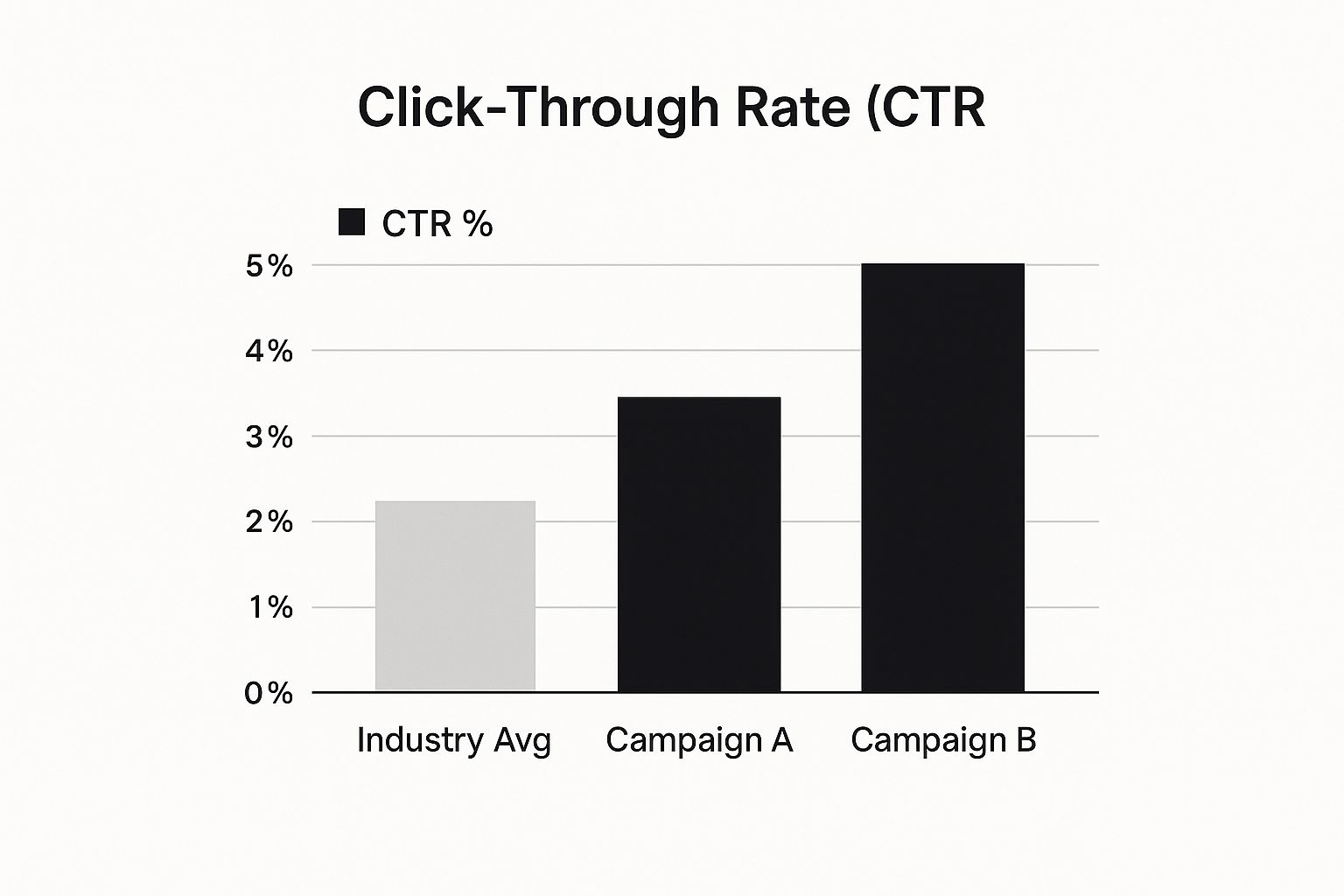What is Click Through Rate? Boost Your SEO & PPC Results

Click-through rate, or CTR, is one of those core metrics you’ll hear about all the time. But what is it, really? Simply put, it’s the percentage of people who see your link or ad and actually click on it.
Think of it as a quick scorecard for how appealing your online content is at first glance. A higher CTR usually tells you that your message is hitting the mark and feels relevant to your audience.
Defining Click Through Rate in Simple Terms

Let’s ditch the jargon for a second. Imagine your ad or search result is a storefront window on a busy high street. The total number of people who walk past and see your display? Those are your impressions.
Now, think about the people who liked what they saw enough to stop, open the door, and come inside. Those are your clicks.
Click-through rate is just the percentage of people who saw your window display and decided to pop in. It’s a direct measure of how well your creative and messaging grab attention right out of the gate.
The CTR Formula Explained
Calculating CTR is refreshingly simple. You just take the total number of clicks your ad or link got, divide it by the number of times it was shown (impressions), and then multiply that figure by 100 to turn it into a percentage.
The formula is: (Total Clicks ÷ Total Impressions) x 100 = Click-Through Rate (%)
For instance, if your Google Ad was shown 1,000 times and pulled in 50 clicks, your CTR would be 5%. The maths here is (50 ÷ 1,000) = 0.05, and then 0.05 x 100 = 5%.
This little calculation is fundamental in so many areas of digital marketing, especially for pay-per-click campaigns. If you’re new to the game, you can see how this fits into the bigger picture in our guide explaining what is PPC advertising.
The Core Components of Click Through Rate
To really get to grips with CTR, it helps to see the moving parts side-by-side. Here’s a quick reference for the essential terms you’ll need.
| Metric | Definition | Role in the CTR Formula |
|---|---|---|
| Clicks | The number of times a user clicks on your link, ad, or call-to-action. | This is the numerator (the number on top) in the equation. |
| Impressions | The number of times your link or ad is displayed on a screen. | This is the denominator (the number on the bottom). |
Getting your head around these two simple inputs is the very first step. Once you’ve got this down, you’re ready to start properly analysing how well your headlines, ad copy, and overall campaign creative are performing.
Why CTR Is a Critical Marketing Signal

Click-through rate is so much more than a simple percentage. Think of it as a direct line of communication between you, your audience, and the ad platforms you’re using, whether that’s Google or Meta. A high CTR is your audience telling you, loud and clear, that your ad has hit the mark.
It’s the ultimate real-time feedback on your marketing. Is your headline grabbing attention? Are your images stopping people from scrolling? Does your call-to-action actually make someone want to click? Your CTR answers these questions instantly.
And the platforms are listening in. When they see a consistently high CTR, they recognise that you’re delivering a great user experience. That’s exactly what they want, and they’re more than happy to reward you for it.
The Connection to Quality Score and Costs
In the world of PPC, your CTR is a cornerstone of campaign health and efficiency. Google, for example, uses it as a massive component of its Quality Score calculation. A higher CTR nearly always leads to a better score.
So why should you care? Because a strong Quality Score unlocks two of the biggest perks in PPC:
- Lower Costs: Google rewards relevant, high-CTR ads with a lower cost-per-click (CPC). Simple as that. Your budget stretches further.
- Better Ad Positions: Ads with higher Quality Scores often get bumped up the page, even if your bid isn’t the absolute highest.
This means a better click-through rate doesn’t just drive more traffic; it brings in cheaper and more visible traffic. Getting your head around this relationship is crucial, and you can dive deeper into how to improve your Google Ads Quality Score in our detailed guide.
Ultimately, keeping a close eye on your CTR lets you diagnose campaign problems on the fly. You can spot underperforming ads in an instant, figure out which creative elements are resonating, and get a much clearer picture of what truly makes your audience tick.
Understanding Good CTR Benchmarks in the UK
Figuring out what makes a ‘good’ click-through rate in the UK is a bit like asking “how long is a piece of string?” The honest answer from anyone in the trenches is always: it depends. A fantastic CTR for a Google Search ad would look totally different from a strong performer on Facebook or in your latest email blast.
Context is absolutely everything.
The biggest reason for this difference comes down to one thing: user intent. Someone typing “best running shoes for flat feet” into Google is actively on a mission. They want a solution, making them far more likely to click on a relevant ad. On the other hand, a user casually scrolling through their social media feed is in a much more passive, discovery mindset.
This gulf in user behaviour directly shapes how your ads perform. An ad has to work much harder to interrupt someone’s social browsing than it does to simply answer a direct search query. Naturally, this leads to very different engagement levels across platforms.
This chart shows just how much performance can vary between a general industry average and a couple of well-run, optimised campaigns.

As you can see, while the standard benchmark might seem a bit low, the targeted efforts in Campaign A and Campaign B managed to more than double the average CTR. That’s the power of optimisation.
Average UK Click Through Rate by Channel
To give you a realistic starting point, it’s useful to look at some typical CTRs you might see across different channels here in the UK. A rate that seems low in one channel could actually be exceptional in another. Each platform has its own rhythm and user expectations.
| Channel | Average CTR (%) | Key Influencing Factor |
|---|---|---|
| Google Search Ads | 3-5% | High User Intent: People are actively searching for what you offer. |
| Social Media Ads | 2.50% | Passive Browsing: Ads must interrupt and capture attention. |
| Email Marketing | 2-4% | List Quality: A highly engaged, segmented list is crucial. |
Looking at these figures, it’s clear there’s no single magic number for a “good” CTR. It’s a moving target that depends entirely on your channel, industry, and campaign goals. The real key is to benchmark against the right averages and focus on constant improvement, not chasing a universal figure.
Of course, CTR is just one piece of the puzzle. It’s one of several crucial key performance indicators for digital marketing that you need to keep an eye on. Monitoring them all together is the only way to get a true picture of your campaign’s health and overall success.
The Key Factors That Influence Your CTR
Your Click-Through Rate isn’t just some random number that pops up in your reports; it’s a direct result of the signals you’re sending to your audience. Getting more clicks means getting several key things right, all at once, to make your ad or search result impossible to ignore. Think of it like cooking a great dish – every single ingredient has to be spot on.
It all starts with relevance. This really boils down to two things: your ad copy and your creative. Your headline and description have to speak directly to what the user is looking for. If someone searches “waterproof running jackets,” your ad needs to shout that exact phrase back at them and promise the perfect solution. Being vague is the fastest way to get scrolled past.
On that same note, your visuals – whether it’s an image or a video – have to grab attention and match the message. A blurry or totally unrelated picture will kill the vibe of even the best headline, sending users on their way.
Targeting and Trust Signals
Beyond the ad itself, who you’re showing it to is just as critical. Audience targeting is a massive piece of the puzzle. You can have the best ad in the world, but if you show it to the wrong people, you’re just throwing money away and your CTR will be abysmal. Getting your targeting right ensures your message lands in front of people who are actually interested in what you’re selling.
Brand recognition also has a surprisingly big impact. Let’s be honest, people are far more likely to click on a name they already know and trust.
Recent UK search data backs this up, showing that branded search terms have a huge advantage. For branded searches, the top two desktop positions saw a combined CTR jump of 3.08 percentage points. It just goes to show that familiarity really does breed clicks. You can dig into the full UK CTR study to see more on this.
Finally, don’t forget the little things that build trust. Features like ad extensions in Google Ads can add extra info – like reviews, site links, or your location. This not only builds credibility but also makes your ad take up more precious screen space, pushing your competitors down and drawing the user’s eye right where you want it.
Actionable Strategies to Improve Your CTR

Alright, knowing what influences your click-through rate is a great start. But the real competitive edge comes when you start actively improving it. The key is to stop theorising and start testing with a structured approach.
This process is what we call A/B testing. It’s simple, really: you run two versions of an ad with one small change between them to see which one performs better. You can test anything from headlines and calls-to-action (CTAs) to imagery, helping you pinpoint exactly what resonates with your audience.
Refine Your Ad Copy and Targeting
Your ad copy is your first impression. To make it count, it needs to be specific, compelling, and super relevant to what the person just searched for.
Here are a few tactics you can put into action right away:
- Hook Readers with Your Title: Use numbers, brackets, and recent dates in your page titles and ad headlines. Think about it: a title like “11 Easy Ways to Boost Sales [2024 Guide]” is far more clickable than something generic.
- Write Compelling Meta Descriptions: Don’t just stuff keywords here. Use this space to answer a user’s potential question and create a sense of urgency or curiosity that makes them want to click.
- Use Negative Keywords: In the world of PPC, negative keywords are your best friend. They stop your ads from showing up for irrelevant searches, which means you’re not wasting impressions on people who were never going to click anyway.
By tightening up your message and controlling who sees it, you ensure your impressions are high-quality, which naturally makes clicks more likely.
Another powerful way to boost your CTR in paid search is to simply take up more space on the screen. You can achieve this using various tools that add extra information to your ads. We’ve written a whole guide on how to use AdWords ad extensions like callouts and reviews to make your ads bigger, more informative, and ultimately, more clickable than your competitors’.
Have Questions About Click-Through Rate?
As you start getting to grips with click-through rate, a few questions always seem to pop up. Let’s run through some of the most common ones to clear up any confusion and help you put this metric to good use in your day-to-day marketing.
One of the biggest mix-ups is the difference between CTR and conversion rate. It’s absolutely vital to know they measure two completely different things.
Click-Through Rate tells you what percentage of people clicked on your ad or link. Think of it as a measure of how interesting or relevant your ad is at first glance.
Conversion Rate tells you what percentage of people took the action you wanted after they clicked, like buying something or filling out a form.
A high CTR is fantastic—it means your ad copy and creative are hitting the mark. But if all those clicks aren’t turning into sales or leads, you don’t have a click problem; you have a conversion problem.
Is CTR a Direct SEO Ranking Factor?
Now, this is a hot topic in the SEO world. While Google has never come out and said that organic CTR is a direct ranking signal, there’s a pretty strong link that’s hard to ignore. A high organic CTR suggests to Google that your result is exactly what people are looking for.
Think of it this way: say your page is ranking at position four, but it’s getting more clicks than the results in positions one, two, and three. Google’s algorithm might see that as a big clue that your page is a better answer for that search. Over time, that user behaviour could definitely help nudge your rankings up. So, while it might not be a direct input, a strong CTR is a seriously positive signal you want to be sending.
How Often Should I Check My CTR?
Honestly, how often you should check your CTR really depends on the type of campaign and how long it’s been running. A brand-new Google Ads campaign, for example, probably needs a daily look-in for the first week just to spot any glaring issues with your ads or targeting.
Here’s a simple guideline you can follow:
- New PPC Campaigns: Check daily for the first week, then you can ease off to every few days.
- Mature PPC Campaigns: A weekly check is usually plenty to keep an eye on performance and spot any trends.
- Organic SEO: A monthly dive into Google Search Console is perfect for finding pages with a low CTR that could do with a bit of a tune-up.
- Email Campaigns: Have a look at your CTR 24-48 hours after sending to see how well it landed with your audience.
You don’t need to be obsessed with checking your CTR constantly. It’s all about getting into a regular rhythm that lets you make smart, data-driven decisions without drowning in numbers.
Feeling a bit overwhelmed by the data? Let the experts at PPC Geeks manage your campaigns to get the most out of your click-through rate and drive real results. Get in touch with our team today at https://ppcgeeks.co.uk.
Author
Search Blog
Free PPC Audit
Subscribe to our Newsletter
The Voices of Our Success: Your Words, Our Pride
Don't just take our word for it. With over 100+ five-star reviews, we let our work-and our satisfied clients-speak for us.
"We have been working with PPC Geeks for around 6 months and have found Mark and the team to be very impressive. Having worked with a few companies in this and similar sectors, I rate PPC Geeks as the strongest I have come across. They have taken time to understand our business, our market and competitors and supported us to devise a strategy to generate business. I value the expertise Mark and his team provide and trust them to make the best recommendations for the long-term."
~ Just Go, Alasdair Anderson
